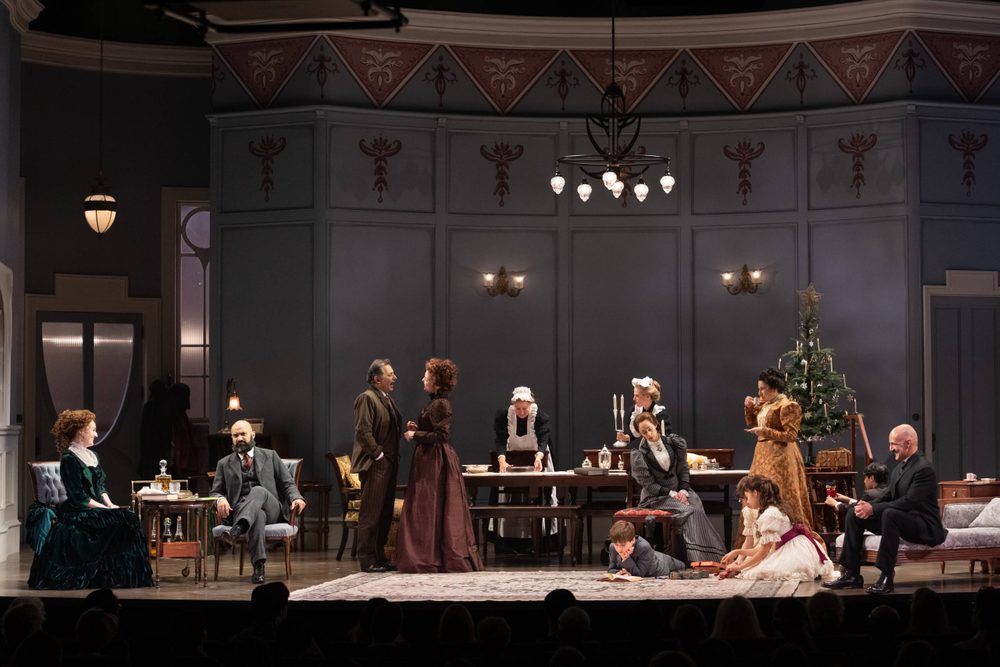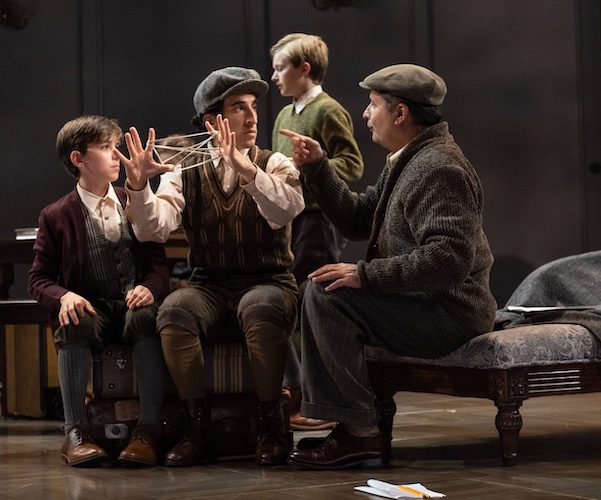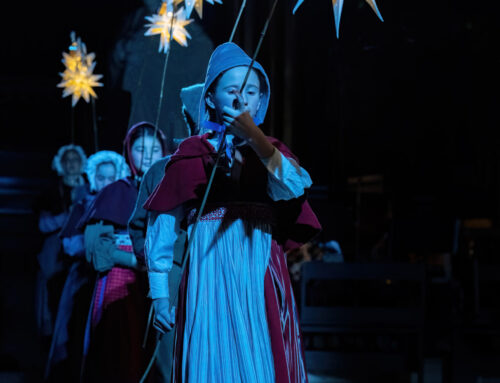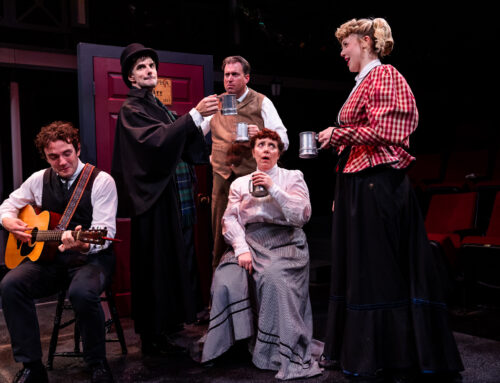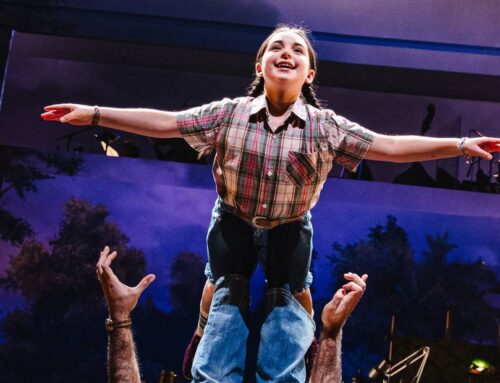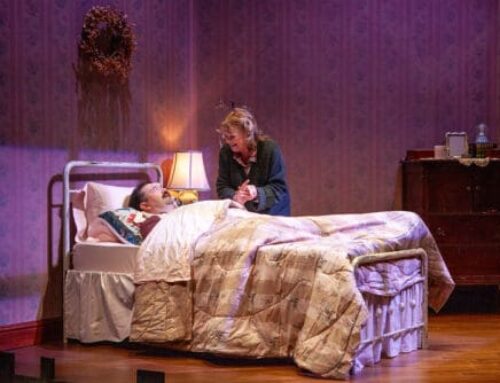THE HUNTINGTON just opened its season with what may be the dazzling Tom Stoppard’s last play “LEOPOLDSTADT.” I saw it on Broadway where it won the TONY Award for Best Play, and thought it not substantial enough to bear the weight of the playwright’s experience at its core. The Huntington’s production directed by Carey Perloff was more engaging and better staged. It left me reeling from the horror at the heart of this fictional family saga, a tragedy endured by thousands of real Jewish families– including Stoppard’s own. The Huntington’s LEOPOLDSTADT must be seen!
The play distills the tragic plight of the Jews through one wealthy Viennese family who came from Leopoldstadt. Named for the emperor who hated and had expelled the Jews from this Viennese suburb, Leopoldstadt (which means Leopold’s city) was a place which was never theirs. But this successful, educated family having risen from the ashes of that calamitous history, thought themselves more Austrian than Jewish and felt firmly established in the upper echelons of society in turn of the century Vienna. Indeed, as the preeminent artists, scholars, scientists, and philosophers of the day, Jews were at the forefront of western culture. Our knowledge of what would befall them is a pall over the action.
The opening scene finds this family–parents, aunts, uncles, cousins, and servants ensconced in their elegant home decorating a tree for Christmas and perusing a family album. Tellingly, some old photos cannot be identified, and the kids unwittingly place a six-pointed Jewish Star of David atop the Christmas Tree. Indeed, the vestigial remains of this family’s Jewish identity will eventually come into full focus before the play is over, but this is a vibrant and even funny introduction to the familial and philosophical dynamics of a menagerie of intermarried Christians, converts, and Jews. Thank god for the family tree in the program (along with detailed photos/bios of actors in multiple roles) as I scrambled to keep track of who was who!
Stoppard has positioned this family at the pivotal intersection of forgetting and remembering, much like himself as he confronts his rediscovery of his own buried Jewish roots and the impetus for this complex saga. This seems to be Stoppard working it out at the end of his life, and perhaps a mea culpa for not embracing the complexity of his own heritage and speaking up sooner? In any case, the conundrum of the Jewish identity is at the forefront of the drama and remains as impenetrable as the metaphorical Riemann hypothesis which Uncle Ludwig, a mathematician, is obsessed with solving.
It seems neither Christian conversion nor genius has afforded Jews the luxury of belonging. Wealthy textile merchant Hermann (Nael Nacer) and his scholarly brother-in-law Ludwig (Firdous Bamji) spar mightily over the subject of identity and assimilation. The conservative capitalist Hermann has convinced himself that times are changing, if slowly. The deeper thinker Ludwig quips that assimilation is more likely for a Druid than a Jew. Later a humiliating scene between Hermann and a cad of a German dragoon named Fritz (Samuel Adams in an ironic dual role as the upright English journalist Percy) proves Ludwig’s point. This scene was more profoundly devastating in the NY production where Fritz virtually guts Hermann alive. I missed the power of that crucial scene which underscores the terror lying in wait.
The play lurches forward in time over half a century as the family grows. There’s the decadence of 1924 where Stoppard is still having fun with the absurdity of the family’s newest baby being baptized and circumcised in the same week. When a lawyer (mistaken for a mohel) produces a cigar needing to be snipped– can a joke about a bris be far behind? Masterful scenic and lighting designs (Ken MacDonald and Robert Wierzel)) however, indicate sinister forces gathering outside. Scene by scene, the set is subtly deconstructed, growing brighter with electric light, then dimmed again by the darkness closing in on them as they huddle, their home gradually stripped of ornamentation and lit by a bare bulb. It’s now 1938, and the unadorned truth will out: there’s no escape from the antisemitism that will result in the slaughter Europe’s Jews.
The last scene set in 1955 is a troubling coda. Stoppard’s inspiration for Leopoldstadt is his own family history. Raised as an Englishman by a Czech mother and English father, Stoppard in his 50’s discovered his completely Jewish background. All of his grandparents died in the holocaust. Throughout the play I wondered what bearing this would have on the play. Then, in the play’s penultimate scene, a now grownup family member re-appears, Stoppard-like, a naive young Englishman whose original name “Leopold” has been anglicized to “Leonard” and who knows little about his Jewish background. When challenged by a cousin, Leonard (Mishka Yarovoy) defends his ignorance, professing no recollection of a childhood experience the night “trouble” knocked on his family’s door–until he suddenly comes face to face with those anguished memories through a physical moment that has resonance in Stoppard’s own life. For me this denouement falls a little flat.
Leonard’s reasons for “not knowing” don’t fully account for Stoppard’s reasons, but the character invites comparison. Unlike Leonard, Stoppard was aware of his Jewish identity for decades, but he doesn’t probe such reticence or ambivalence here. I can’t resist wondering why it took this presumably intellectually curious playwright so long to explore his Jewish identity. The play keeps us at arm’s length from the perhaps painful recesses of that awareness. Arguably, Stoppard’s personal connection to this history and his reaction to it, offer the most fertile ground for drama and fresh perspective on a past which is now being challenged and as witnesses are disappearing. Instead, he tells us mostly what we already know about Jews who were betrayed by what they considered their OWN country and which they had defended with their lives. So why write this play at all?
The last scene suggests an answer: the reclaiming of what is disappearing… faces fading from memory in the family album, more like “rumors” than real people as Stoppard puts it in the first scene. In the last scene he circles back to a golden time, and these faces appear onstage again, framed up and looking out at us from the shadows, a family safe at home imagining a promising future. They are framed up to break our hearts. Thanks to the vividness of this superb ensemble, I see these faces clearly. As a litany of names is intoned like a prayer–those who survived, those who did not, those who carried on– we are left with a mystery. Why the pervasive and persistent hatred of a people who continue to seek, unchallenged, a home on this earth?
SEE LEOPOLDSTADT at The Huntington through October 13!

